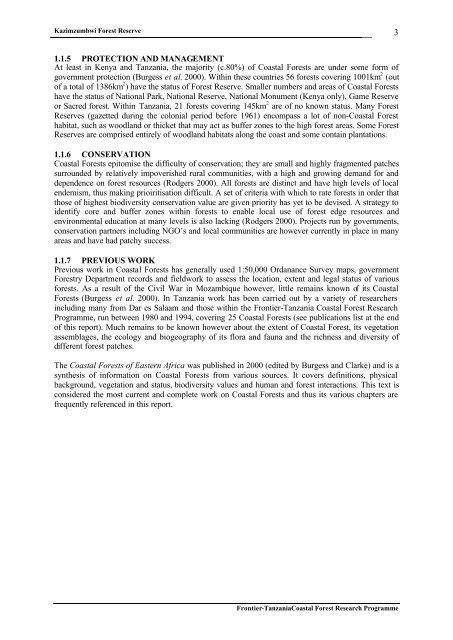Frontier Tanzania Environmental Research REPORT 110 ...
Frontier Tanzania Environmental Research REPORT 110 ...
Frontier Tanzania Environmental Research REPORT 110 ...
Create successful ePaper yourself
Turn your PDF publications into a flip-book with our unique Google optimized e-Paper software.
Kazimzumbwi Forest Reserve<br />
3<br />
1.1.5 PROTECTION AND MANAGEMENT<br />
At least in Kenya and <strong>Tanzania</strong>, the majority (c.80%) of Coastal Forests are under some form of<br />
government protection (Burgess et al. 2000). Within these countries 56 forests covering 1001km 2 (out<br />
of a total of 1386km 2 ) have the status of Forest Reserve. Smaller numbers and areas of Coastal Forests<br />
have the status of National Park, National Reserve, National Monument (Kenya only), Game Reserve<br />
or Sacred forest. Within <strong>Tanzania</strong>, 21 forests covering 145km 2 are of no known status. Many Forest<br />
Reserves (gazetted during the colonial period before 1961) encompass a lot of non-Coastal Forest<br />
habitat, such as woodland or thicket that may act as buffer zones to the high forest areas. Some Forest<br />
Reserves are comprised entirely of woodland habitats along the coast and some contain plantations.<br />
1.1.6 CONSERVATION<br />
Coastal Forests epitomise the difficulty of conservation; they are small and highly fragmented patches<br />
surrounded by relatively impoverished rural communities, with a high and growing demand for and<br />
dependence on forest resources (Rodgers 2000). All forests are distinct and have high levels of local<br />
endemism, thus making prioiritisation difficult. A set of criteria with which to rate forests in order that<br />
those of highest biodiversity conservation value are given priority has yet to be devised. A strategy to<br />
identify core and buffer zones within forests to enable local use of forest edge resources and<br />
environmental education at many levels is also lacking (Rodgers 2000). Projects run by governments,<br />
conservation partners including NGO’s and local communities are however currently in place in many<br />
areas and have had patchy success.<br />
1.1.7 PREVIOUS WORK<br />
Previous work in Coastal Forests has generally used 1:50,000 Ordanance Survey maps, government<br />
Forestry Department records and fieldwork to assess the location, extent and legal status of various<br />
forests. As a result of the Civil War in Mozambique however, little remains known of its Coastal<br />
Forests (Burgess et al. 2000). In <strong>Tanzania</strong> work has been carried out by a variety of researchers<br />
including many from Dar es Salaam and those within the <strong>Frontier</strong>-<strong>Tanzania</strong> Coastal Forest <strong>Research</strong><br />
Programme, run between 1980 and 1994, covering 25 Coastal Forests (see publications list at the end<br />
of this report). Much remains to be known however about the extent of Coastal Forest, its vegetation<br />
assemblages, the ecology and biogeography of its flora and fauna and the richness and diversity of<br />
different forest patches.<br />
The Coastal Forests of Eastern Africa was published in 2000 (edited by Burgess and Clarke) and is a<br />
synthesis of information on Coastal Forests from various sources. It covers definitions, physical<br />
background, vegetation and status, biodiversity values and human and forest interactions. This text is<br />
considered the most current and complete work on Coastal Forests and thus its various chapters are<br />
frequently referenced in this report.<br />
<strong>Frontier</strong>-<strong>Tanzania</strong>Coastal Forest <strong>Research</strong> Programme

















